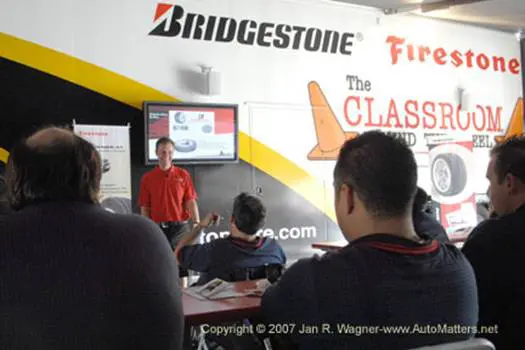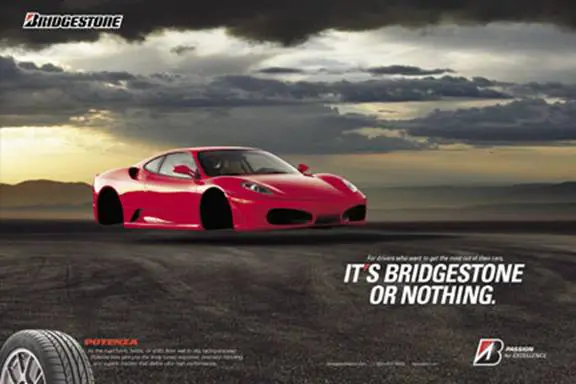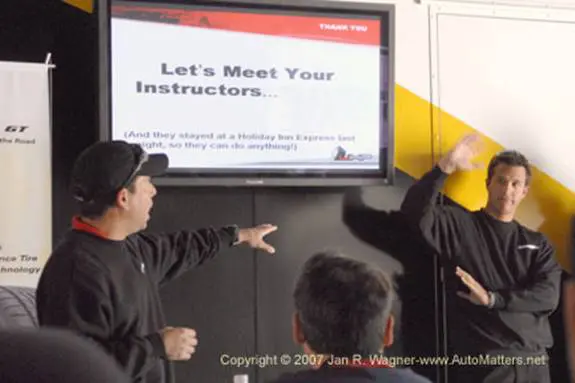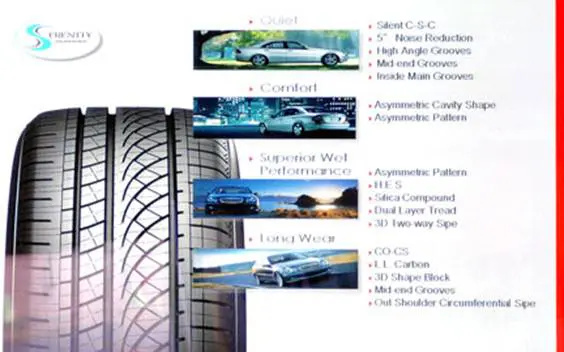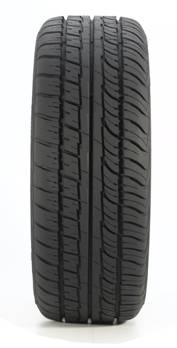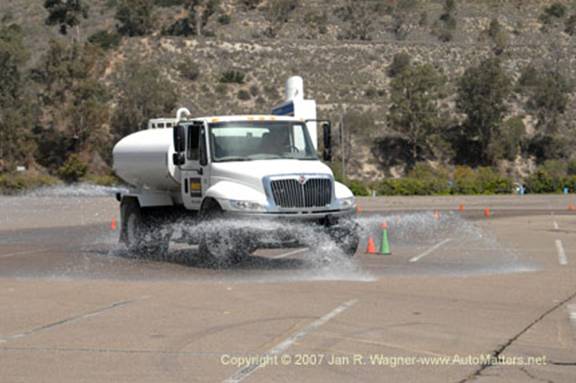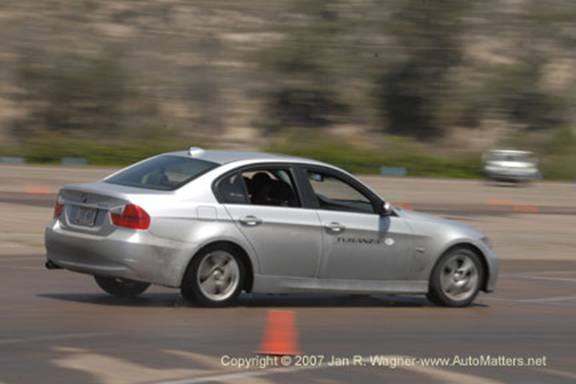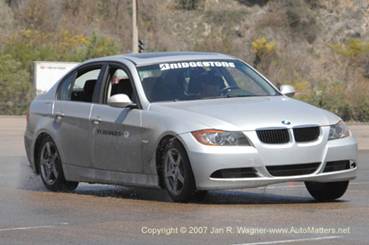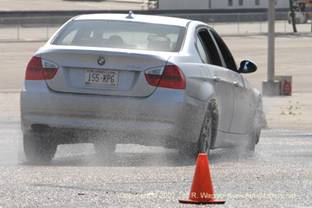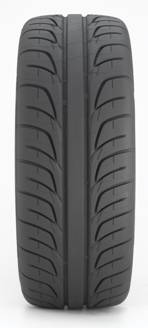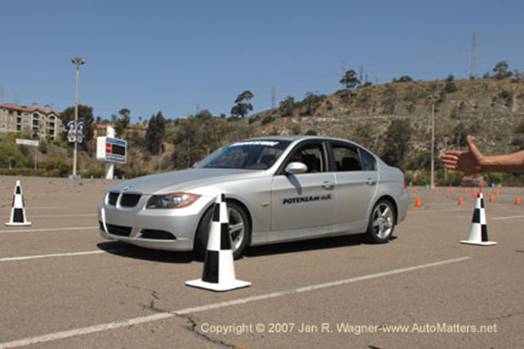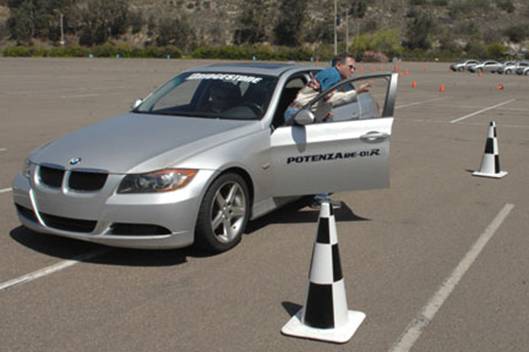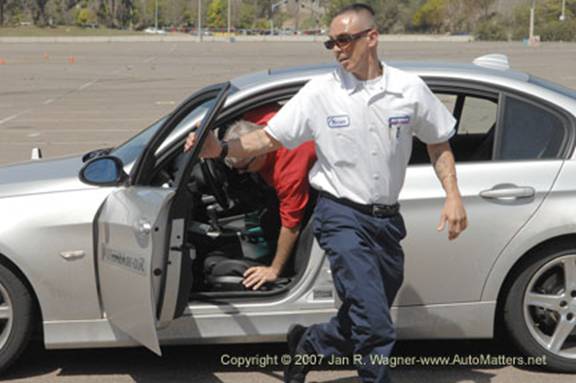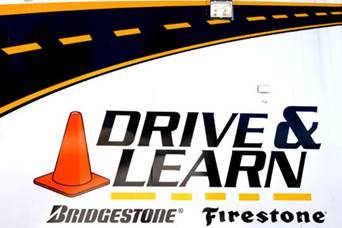
Bridgestone Firestone “Drive & Learn”
“Drive & Learn – The Classroom Behind the Wheel”
& News about a Program for Young Drivers
I recently went back to school for a few hours to learn about tire choices. In addition to the informative in-classroom training, we also got plenty of behind-the-wheel experience on the track to go along with what we learned in-class.
The school was taught by Bridgestone Firestone. Utilizing two large, 18-wheel transporters, 8 cars, 60-100 tires, eight instructors and more, it travels to locations around the country to help people become more knowledgeable about tires in general and, of course, to showcase Bridgestone and Firestone tires.
In San Diego there were four sessions offered in Qualcomm Stadium’s large west parking lot: two in the morning and two in the afternoon, spread over two days. The program conveyed its messages effectively. Course materials included a 36-page “Participant Guide” which contained lots of useful information. Thoughtfully, they even kept us well fed. That went a long way towards helping to keep my mind focused on what they were trying to teach us. Students in my particular group were from some tire dealerships.
In the classroom the multi-media presentation was led by instructors, who answered our questions.
We were told about some Bridgestone and Firestone tires, learned tire safety tips, were entertained by some television advertisements and found out about Bridgestone Firestone’s wide-ranging involvement in professional motorsports. Trends were discussed regarding the increased use of all season tires, low aspect ratio tires, higher speed-rated tires, run-flat tires and tire pressure monitoring systems – which we are already starting to see in the automotive aftermarket and on new vehicles coming to car dealer showrooms.
As wonderful as it would be, it is impossible to have one tire that is, at once, soft and sticky with a wide, smooth contact patch to maximize its performance on a dry, smooth race track; deeply grooved to channel water well in heavy rain, and give good traction in snow and mud; hard enough to last through 80,000 miles of use (and occasional abuse) and deliver low rolling resistance for great fuel economy; and equally well-suited for use on a small, light economy car or a large, heavy, 18-wheel transport truck. These are contradictory characteristics. Consequently there are different models of tires which are either optimized for certain specific applications or are somewhat of a compromise, to make them suitable for a wider variety of real-world, everyday driving situations and applications. Two of the tires that were demonstrated to us fit into that broad, latter range of categories.
The “Bridgestone Turanza™ with Serenity Technology” is engineered for a combination of wet and dry handling performance, long tread life and a luxurious, comfortable and quiet ride. Depending on its “speed rating” (H, V and W), it comes with a limited warranty to deliver 45,000, 50,000 or 70,000 miles of treadwear life. It is intended for use on what they described as premium touring cars.
The “Firestone Firehawk™ GT with Uni-T®” is designed more for aggressive driving performance. It is wider, for improved cornering and traction, and its tread pattern and compound are further designed to provide “rock-solid control on wet surfaces.” “Inside tread blocks feature smaller elements with more edges for improved all-season traction. Outside tread blocks feature larger elements for improved dry handling.” This tire is intended for use on high performance cars.
Both tires come with a “Buy & Try, 30-Day Guarantee.”
Outside, we got seat time in cars on a track. The cars were the BMW 325i and the Pontiac G6 V6. Some of the cars were fitted with Bridgestone and Firestone tires, while others were fitted with competitive tires from other manufacturers.
The track was thoroughly soaked and then the professional instructors demonstrated took us for rides to demonstrate what they wanted us to do. Then each of us drove so that we could experience first-hand “the differences between grip, noise levels, acceleration and braking characteristics of several tires.”
Throughout our track time we experienced and witnessed major, significant differences between the tire makes and models. Not surprisingly, the various Bridgestone and Firestone tires performed better than the tires from the competition.
Speeding through the wet, slippery autocross course was much more predictable and controllable on them. That translated into noticeably quicker driving through the turns – as opposed to pushing straight off of the corners and plowing through the cones.
The highlight of our session came towards the end of our track time, when we were all divided up into teams, assigned one instructor per team and given the opportunity to participate in an exciting, surprisingly intense and challenging driving competition.
The BMW which we all shared was fitted with “Bridgestone® Potenza™ RE-01R™ with UNI-T™ technology” tires. These tires were designed for high performance on the street and track, and are targeted towards enthusiast drivers. As we would soon learn, they stick very, very well. I underestimated their level of grip and drove more slowly that I needed to. I wonder how well they might perform in one of our SCCA autocrosses.
Each of us began our turn in the competition with a Le Mans type start. We had to wait until we were ‘tagged’ by the teammate who preceded us.
Then we had to sprint to the car.
Once there, we had to get in and fasten the seat belt before we could start to drive on the autocross course. Then the instructor, who was in the passenger seat, released the parking brake and allowed us to go.
Next, we each raced as quickly as we dared around the dry autocross course. We would be penalized for any cones hit, so it was essential that we maintain complete control of our car.
Once back, we had to stop precisely within the tight confines of a stop box (or suffer a further penalty).
With our car parked in the box, we got out, ran back to our team and tagged the next driver.
After every student on the team had taken their turn, the instructor scrambled over the center console into the driver’s seat and made one final hot lap around the course. The team with the best combined times won.
Bridgestone Firestone’s “Drive & Learn” also included a CD, which was packed with useful information including a 21-page document by Mario Andretti on driving and vehicle safety, information about the Bridgestone Racing Academy and an introduction to Driver’s Edge 2007 – a classroom and driving program for young drivers. Bridgestone Firestone and Driver’s Edge have partnered to present this safety program which enables young drivers (aged 15 – 21 and with a valid learner’s permit or license) to receive free accident avoidance training during the Driver’s Edge 2007 national tour. It is said to include: written tests designed to measure students’ driving knowledge before and after completing the course; classroom and behind-the-wheel defensive driving instruction on skid control, evasive lane changes, anti-lock braking skills and panic-braking techniques; interaction with local law enforcement, including impaired driving awareness and seat belt safety instruction; and a session on proper car maintenance, based on Firestone Complete Auto Care’s Car Care Academies. If this program is even half as good as it sounds, everyone – not just young people, would benefit from taking it. I would like to take it too.
Unfortunately I waited to review the CD until I sat down to write this AutoMatters column. Since I have two teenaged drivers, I was very disappointed to learn that by the time I read about it, the San Diego stop on the tour had already taken place. Taking this course could someday save their lives. However, for those of you who live in other cities, there are other stops. To learn more and for registration information, visit www.driversedge.org or phone (877) 633-EDGE.
Drive safely and do join me again next time.


